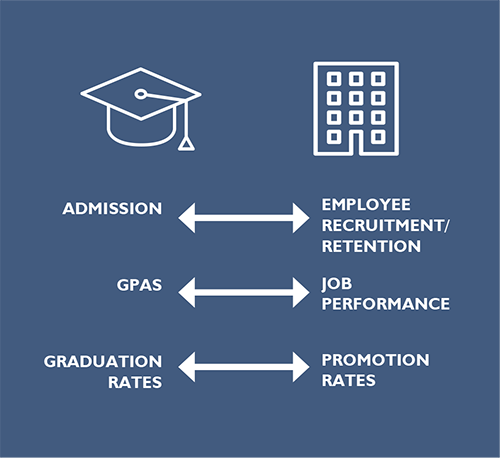5 Tips for Adopting Collegiate Design in the Office

Is your organization or organizations you work with struggling to attract and retain young employees? Everyone is searching for that one differentiator in the race for talent - how to edge out competitors when vying for the best and brightest. Interestingly enough, many corporate employers we speak with at AECOM from the CEO to the HR recruiter often forget the importance of work environment and workplace design when “wooing” would-be job candidates.
When going on a job interview an applicant puts their best foot forward - dressing to impress, polishing their resumes and prepping for those anxiety-provoking, curveball interview questions. Are companies doing the same?
The newest generation of employees pose different challenges to recruiters. Millennials and Generation Z, who are just now entering the workforce, are vocal about their workplace priorities. Millennials will account for nearly 75% of the workforce by 2030 and their preferred work styles and priorities cannot be ignored. Priorities include work/life balance, flexibility, technology and transparency - subjects that matter to young job applicants but topics many companies still struggle to clearly define.
Workplace design is also a key consideration for young job-seekers when vetting employers. Recent grads have just spent 4-6 years on college campuses where study and work styles differ greatly from corporate America. Step foot on a college campus today and I guarantee it will look and feel much different than your typical office.
The definition of “work” is quickly changing with this new generation of worker. Rather than ask recent grads to conform and risk losing top talent, why not take planning cues from institutions of higher education?
Our prediction - collegiate design is the new driver for workplace design.
What is collegiate design? AECOM recently partnered with KI to host a variety of college campus tours with business leaders. We were able to extract key takeaways about work styles, space planning and implications for work while observing students and collegiate environments.
Before corporations can adopt collegiate design they must first understand the influences and drivers in order to inform their own workplace design strategies and programs. Here are five tips for implementing collegiate design:

1. VISIT
Companies willing to refresh or develop new workplace strategies and environments should consider “going back to school” by visiting higher-education campuses. Schedule time to observe the similarities and differences between students learning and employees working. Our suggestions include:
- Target schools from which your company hires.
- Also target schools that stretch and challenge your company as it relates to talent, growth, vision and culture.
- Select two to three schools that meet your criteria and schedule a half day to visit each.
- Bring a cross-section of human resources, facilities, real estate and department leaders.
2. OBSERVE
It’s important to observe students during active periods while classes are in session in order to capture their “typical” learning activities. Grab photos and short videos on a smart phone to record anomalies and scenarios. When observing:
- Compare and contrast college work styles and environments with that of your organization.
- Don’t miss the opportunity to look at non-traditional environments. They can greatly inform your workplace plans.
3. PLAN
Companies will likely come away with an extensive list of observations. It’s important to create a plan that incorporates the right observations. Start by identifying those that mesh well with company culture, goals and vision. There can be a few divergent or new observations to test as well. Keep these considerations in mind when planning:
- Remove silos. Challenge the group to break down barriers in departments and segments and cross-integrate for more dynamic exchanges and environments.
- Plan holistically and authentically. Consider all aspects of an environment when testing new ideas. This will mitigate the risk of failure with one-off ideas not supported by existing corporate initiatives.
- Consider central core concepts. The central core is a guiding principle in most campus environments. Much of what companies may observe in physical spaces emphasizes a central core layout or hub - a gathering place for an entire building. Such spaces are high in energy and interactivity, yet facilitate both collaboration and quiet concentration.
- Maximize external space. Capitalize on their use in accommodating groups of all sizes. While spaces may be designed for specific use, many students create their own ways to use exterior spaces to interact, study/work and socialize.
4. IMPLEMENT
Implementation can take many forms. Here are some insights to help smooth the process:
- Initiate pilot programs. When “testing” ideas, try piloting design ideas that are backed by research (campus visits, observations and surveying recent grads).
- Address the convergence of employees bringing their own devices into the workplace and embedded technology within an environment. Define connectivity needs and establish protocols for personal device use. Be prepared to support a range of work styles with technology.
5. TRACK
Tracking employee productivity, collaboration and other metrics resulting from a workplace strategy that incorporates collegiate design is essential to understanding the ROI.
A possible consideration is to correlate collegiate design ROI to workplace design ROI. Campus facilities contribute to a college’s ROI as measured in admission rates, student retention rates, graduation rates and grade point averages. The corporate ROI can be measured in recruitment rates and cost effectiveness, employee retention rates, job performance and satisfaction, and promotion rates.

Subscribe
Stay up to date with the latest trends and more.

